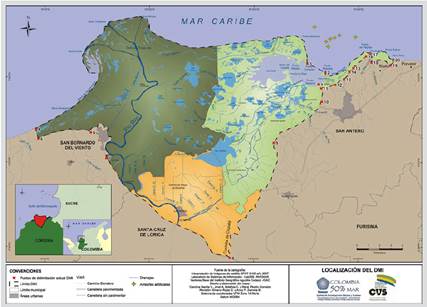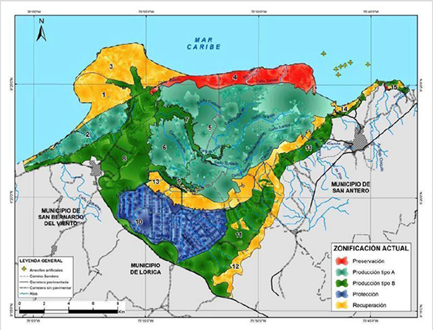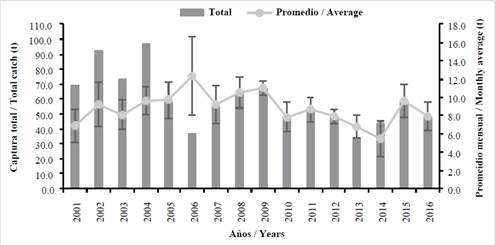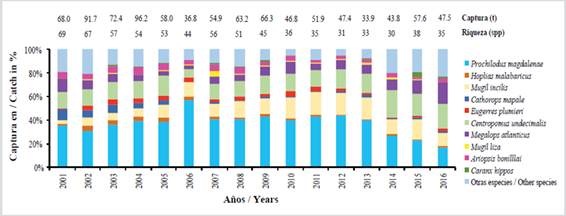Marine and coastal ecosystems are diverse and can be found in 123 countries (Unep, 2006). They are characterized by being very productive in terms of benefits for humans, known as ecosystem or environmental services (ES) which are classified into four types: i) provisioning, ii) regulation, iii) ecological support, and iv) cultural, (Rincón-Ruiz et al., 2014).
According to FAO (2019), one of the main services provided by these ecosystems is fishing, which, along with aquaculture, sustains between 10 % and 12 % of the world’s population. In 2016, fishing produced 171 million tons, 88 % for human consumption (FAO, 2018). However, it is estimated that 33.1 % of the fishing resource is captured beyond the limits of permissible sustainability (biological), presenting a decreasing trend in the percentage of specimens suitable for capture (FAO, 2016).
In Colombia, one of the areas that mirrors this problem is the Cispata Integrated Management District (DMI Cispata) located in the department of Córdoba. There, artisanal fishing is one of the permitted economic activities, using small-scale gear and boats. Currently, bad fishing practices and the use of inappropriate gears put the sustainability of fishing and hydrobiological resources at risk. In addition, the limited capacity of the entities to exercise control and surveillance has led to a reduction in the density, abundance and biomass of commercial species (Solano et al., 2007; CVS-Invemar, 2010).
In response to this problem, in 2018 a “Participatory Fishing Co-management Plan with an Ecosystem Approach” was established (Invemar-Fundación Natura, 2018), laying the groundwork for the signing of agreements among fishermen, the National Aquaculture and Fisheries Authority (AUNAP), the Regional Autonomous Corporation of the Sinú Valleys (CVS), the San Antero City Hall, the Institute of Marine and Coastal Research (Invemar) and the University of Córdoba. However, the signed agreements have not been implemented for various reasons such as the lack of endorsement by the AUNAP and the absence of a local committee to guarantee their fulfillment.
To promote the implementation of these agreements, aimed at regulating artisanal fisheries, this study designed and proposed the basis for structuring a Payment for Environmental Services (PES) scheme. PES are economic instruments that seek to encourage changes in the behavior of agents, through voluntary agreements between users and providers of the environmental service, which imply conditioned actions (Wunder, 2005; Moreno, 2012).
The DMI Cispata is located at the southern end of the Gulf of Morrosquillo, with an area of approximately 130 km2, covering the municipalities of San Antero (36.0 %), San Bernardo del Viento (46.2 %) and Santa Cruz de Lorica (17.8 %) (Figure 1). It is composed of a system of remnants of the old Sinú River delta, halophilic wetlands, alluvial and fluvial-marine beaches, beach areas, swamps, dry forests and other associated ecosystems (CVC-Invemar, 2010). It also consists of a mangrove ecosystem, which provides multiple benefits to local fishing communities (Ecoversa, 2015).}
In accordance with Wunder (2005), who proposes five essential components for the formulation of effective PES schemes, the step-by-step approach for the development of PES in marine and coastal ecosystems, developed by the United Nations Environment Programme (Unep), the Katoomba Group and Forest Trends (2010) and taking complementary elements from Scheufele and Bennett (2013) and Fripp (2014), the components of the scheme were developed from secondary information and semi-structured interviews. The following steps were taken: (i) Characterization of the Environmental Service (ES) and geographical area, (ii) Characterization of supplier agents and beneficiaries, (iii) Establishment of the price of the ES based on the calculation of the opportunity cost, and (iv) Identification of the payment mechanism and institutional capabilities.
Due to its characteristics, the DMI Cispata complies with the conditions established in the Colombian regulations for the application of a PES instrument (Article 60 of Decree Law 870 of 2017). The design of this type of scheme was evaluated under the modality of biodiversity conservation, achieving the following results.
Characterization of the DMI Cispata and the Ecosystem Services (ES)
Artisanal fishing in the DMI Cispata is carried out in bodies of water, distributed in management units, categorized and subdivided according to their potential use (Figure 2) (CVS-Invemar, 2010). These are catalogued as of sustainable use or production and represent 64.3 % of the total protected area, where other traditional economic activities such as forestry and agriculture are also carried out. According to the fishing agreements, there are 29 fishing sites, which comprise a total area of 1609.9 ha, representing 6.6 % of the total area of the DMI Cispata.
Taking as a reference the 6 % population participation for the DMI Cispata, calculated by CVS-Invemar (2010) in relation to the total population of the three municipalities that make up San Bernardo del Viento, San Antero and Santa Cruz de Lorica, it was estimated that there are currently about 9,417 inhabitants (Figure 3), which is equivalent to a population density of 100 inhabitants per km2. It is estimated that 18 % of the population calculated in the DMI Cispata are fishermen.
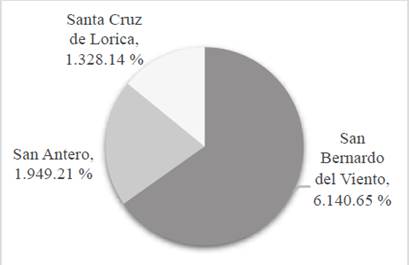
Source: Author’s elaboration based on information from DANE 2018
Figure 3 Number and percentage of inhabitants of the DMI Cispata by municipality 2018.
The species richness in the DMI Cispata, shows a gradual decrease, from 73 species (68 spp of fish and 5 of crustaceans) in 2001, to less than 30 in 2014, meaning a reduction of 56 %. However, in 2016 a slight recovery is observed, reaching 36 spp (Figure 4), meaning a decrease of 47 % compared to the first year evaluated.
According to the data analyzed, there is a year-to-year variation in fish production in the DMI Cispata, which was between 68.8 t in 2001 and 47.5 t in 2016 (Figure 5), with a decrease in catch volumes mostly reflected as of 2005, where productivity in the first four years was not reached or exceeded, reaching the lowest records in 2006 with 36.8 t and 2013 with 33.9 t, and reaching significant increases in 2009 (66 t) and 2015 (57.6 t) (Figure 5).
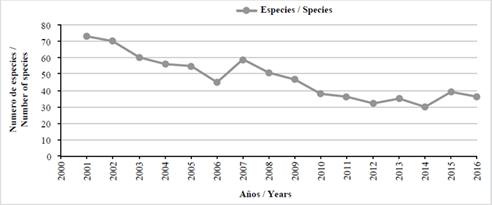
Source: Own elaboration based on data from the URRAInvemar project
Figure 4 Number of species reported between 2001 and 2016 in the DMI Cispata.
Catch composition of species of commercial interest
Among the fish species captured in the DMI Cispata, 10 are considered of greater commercial importance, such as the bocachico (Prochilodus magdalenae) which registers the greatest captures, standing out in 2006 with 57.2 %; the common snook (Centropomus undecimalis) which registered between 13 and 23 % of the captures; the parassi mullet (Mugil incilis) with a participation of 2.6 and 19 % and the tarpon (Megalops atlanticus) of 2.8 and 18.3 %. The 10 species represent between 95 % (2010) and 77 % (2016) of the total catch in the years evaluated (Figure 6).
Identification of ES suppliers and users
In order to identify the providers of the ES, it is necessary to take into account the particularities of the fishing activity, such as the fact that the resources are freely accessible, given the impossibility of guaranteeing property rights. However, the use of the resource can be characterized, which is exercised by fishermen who are inhabitants of the Cispata DMI area and who have traditionally derived their livelihood from artisanal fishing. These fishermen would be the beneficiaries of the incentive and, mostly, are linked to 20 fishing organizations of the DMI Cispata that signed the agreements in 2018.
The report established by Rojas (2020) considers the users or beneficiaries of the ES as those who need to preserve or restore a ES, ensuring the maintenance or improvement for the benefit of other agents; in the case of the DMI Cispata, private companies in the area dedicated to hydrocarbons exploitation, are potential buyers, when implementing processes of corporate responsibility to compensate the environmental impact generated by their economic activity. There are also relevant tour operators, hotels and restaurants in the area, as well as actors associated with road infrastructure and power generation.
ES Price
According to Forest Trends and the Katoomba Group (2010) and Fripp (2014), the price must be satisfactory to the parties, sufficient to become an incentive and to ensure compliance with the rules of the scheme. In the case of the Cispata DMI, the opportunity cost was calculated, that is, how much a fisherman would not receive if he were to adhere to the fishing agreements and cease fishing during the closure periods. The economic rent, calculated for the year 2016 (SIPEIN), was taken as a reference:
The average monthly economic rent for a fixed gillnet fisherman was $1,023,695 in 2016 prices, in 2019 prices this is equivalent to $1,162,629 (scenario in the absence of the PES).
An adaptation period was proposed for the beneficiary fishermen where they would receive the equivalent of a current legal minimum wage (SMLV), which by 2019 would be $980,657 including transportation assistance (scenario with the PES).
Calculating the opportunity cost (CO) we have:
CO = Option chosen - minus the best option not chosen; = $980,657 - $1,023,695 = - $43,038
Although the value of the SMLV is below the actual income for fishermen, the scheme option has other benefits related to: Receiving a fixed monthly monetary payment, recovery and sustainability of the fishing resource, increased economic income related to the capture of larger specimens, appropriation of good fishing practices, and options to diversify the income of fishing households during closed seasons through complementary productive projects.
Payment mechanism and institutional capacities
This step is related to the minimum conditions that the PES scheme in the DMI Cispata must comply with, considering the payment mechanism, type, amount and institutional capacities. For this, following the proposal of Scheufele and Bennett (2013), they made an exhaustive description of each of the components.
Transparency: The terms, conditions, and risks of the PES scheme must be clear to all involved, so that it is effective and does not lose strength. In the case of the DMI Cispata, fulfilling this criterion is feasible considering that the scheme is based on strengthening, through incentives, the compliance of the fishing agreements, by the fishermen that are part of the 20 signing organizations and in the presence of environmental authorities in the area with experience and trajectory in environmental projects (CAR, AUNAP and academia).
Additionality in the provision of the ES: Once the scheme is implemented, an additional offer must be made in the provision of the ES. The PES scheme in the DMI can guarantee additionality by encouraging the capture of specimens above the size of sexual maturity and the establishment of closed seasons that will provide conditions for the recovery of the resource.
Payment conditionality: This criterion should be established from the beginning of the PES implementation, and speaks of the minimum standards that the ES provider must meet to receive the payment, either in cash or in kind. In the case of the DMI Cispata, the conditionality of the payments is related to compliance with the fishing agreements signed by the fishermen. It is important to establish a vigilance and control committee made up mainly of competent authorities and fishermen, so that through monitoring, compliance with the agreements is verified.
Voluntary participation: Participation by agents must be voluntary to safeguard the effectiveness of the PES scheme. In the area under study, there is a good precedent and that is the signing of the fishing agreements that occurred voluntarily in 2018.
Type of agent and form of intervention: The agents must be government entities, NGOs, research institutes, donors or private agents capable of assuming the task of mediation between providers and beneficiaries and, making the PES scheme operational. In the area there are enough agents with the economic and institutional capacity to establish a PES (environmental authorities, private sector, NGOs and academia).
Vendor selection mechanism: It is recommended that the selection of vendors be done through a cost-benefit analysis, which allows the selection of vendors with the highest net benefit and excludes bids that mean net losses for the society (Scheufele and Bennett, 2013). The selection of providers in the DMI Cispata is facilitated by the fact that the records of the 20 artisanal fishermen associations that signed the fishing agreements are used as a starting point; however, it is important to carry out a fishing census to identify the fishermen linked to each association, socioeconomic characteristics and resources to implement the PES.
Type of payment: Can be classified into direct cash or in-kind benefits and indirect benefits (Scheufele and Bennett, 2013). In the Cispata DMI, a combination of direct cash and in-kind payments is recommended to allow ES sellers to replace their fishing gear and decrease pressure on the resource, while complying with the closure periods described in the artisanal fisheries agreement.
Payment system: This is the process used to make the agreed-upon payment and should include a periodicity, the basis for payment, a definition of payment, and a stipulated amount (Scheufele and Bennett, 2013). In the Cispata DMI, a combination of direct cash and in-kind payments is recommended in the initial stage. In order to comply with the closed seasons, it is desirable to offer an economic alternative that supplies the basic needs of fishermen. According to CVS’s experience, projects related to beekeeping, ecotourism and cultivation of home-grown vegetables or orchards could be implemented (Espinosa, 2020).
Measures to establish the efficiency of the scheme: Measures can be based on the inputs used or on the environmental services produced (Scheufele and Bennett, 2013). In the DMI Cispata, the measures will be given by the results of the fishing monitoring that must be implemented when the scheme is in place. The results will demonstrate the effectiveness in relation to the recovery and sustainability of the fishing resource.
Fishing is one of the most important activities for the communities of the DMI Cispata, however, it presents low yields in the catches with a decreasing pattern, going from 95 t in 2004 to 34 t in 2014. The main sellers of the ES identified are all those fishermen belonging to the 20 fishing organizations that signed the fishing agreements and who, under the PES scheme, would be complying with it.
A total of 17 potential ES buyers were identified, belonging to the public (10), private (4) and NGO sectors (3), each with different roles and contributions to the scheme, whose presence and interest in the area favor the implementation of an instrument such as PES schemes. The minimum conditions that the PES scheme must meet were determined, demonstrating that in the DMI Cispata it is viable to implement a PES scheme.











 text in
text in 


